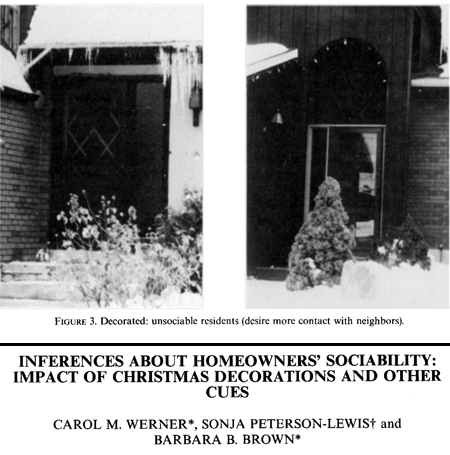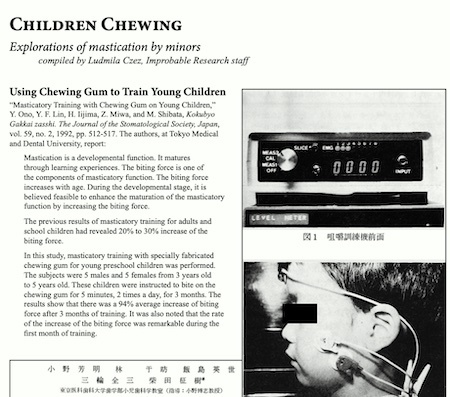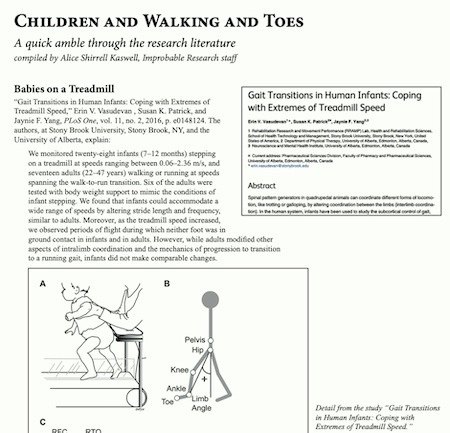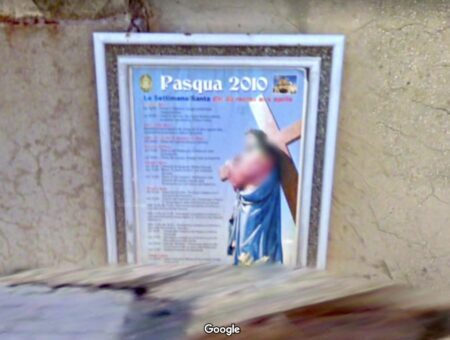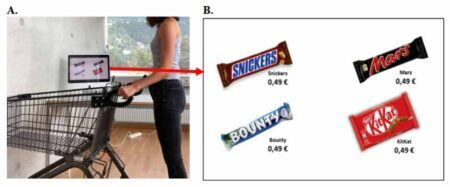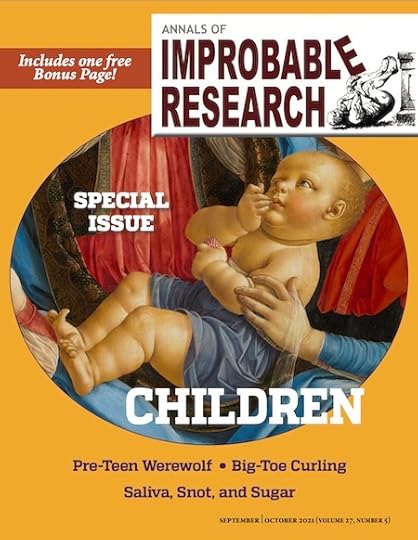Marc Abrahams's Blog, page 65
December 8, 2021
How One American Homeowner Deployed Christmas Decorations
Some homeowners in the USA deploy more Christmas ornamentation than other homeowners, a statistical fact explored in a study, published in 1987, about one of the statistical outliers.
 That study is: “It’s the Thought That Counts: A Case Study in Xmas Excesses“, Richard W. Pollay, Advances in Consumer Research, vol. 14, 1987, pp. 140-143. The author, at the University of British Columbia, Canada, reports:
That study is: “It’s the Thought That Counts: A Case Study in Xmas Excesses“, Richard W. Pollay, Advances in Consumer Research, vol. 14, 1987, pp. 140-143. The author, at the University of British Columbia, Canada, reports:
The old house sits across the street from the most prestigious art gallery in the region, and from early October until January it is decorated with Christmas decorations covering every square inch of available space, inside and out. This attracts a steady stream of cars and pedestrians rubbernecking at the enormous display that many find garish and excessive. Even when the other homes have their holiday decorations up, there remains a striking contrast between the character of the street and this one house….
PUBLIC REACTION—As we might imagine, the children of the neighborhood and in her classes all find this wonderful, quite literally, and are less prone than the adults to be taken aback at the unusualness of it all.
[The homeowner] is less satisfied these days with the respect and interest paid by the reporters and media. She had received a growing amount of attention over the years. First the local newspaper did an annual story, some years supplemented with a feature piece in a regional magazine or the large metropolitan newspaper from nearby Hartford, the state capitol. By 1984 she was appearing as an item on TV news and that year was on a national network. But in 1985, media interest slackened, frustrating her. Even the local media see less interested as, to those reporters who have covered the item once before, the story was no longer new news.
December 7, 2021
Physics of the Running of the People from the Bulls
The running of the people who are running from the bulls at the Running of the Bulls in Pamplona, Spain, offers up some insights, which course through the paragraphs of a newly published study:
“Pedestrian Dynamics at the Running of the Bulls Evidence an Inaccessible Region in the Fundamental Diagram,” Daniel R. Parisi, Alan G. Sartorio, Joaquín R. Colonnello, Angel Garcimartín, Luis A. Pugnaloni, and Iker Zuriguel, Proceedings of the National Academy of Sciences, vol. 118, no. 50, 2021, e2107827118.
The authors, at Instituto Tecnológico de Buenos Aires (ITBA), Argentina; Universidad de Navarra, Pamplona, Spain; and Universidad Nacional de La Pampa, Argentina, report:
We characterize the dynamics of runners in the famous “Running of the Bulls” Festival by computing the individual and global velocities and densities, as well as the crowd pressure. In contrast with all previously studied pedestrian systems, we unveil a unique regime in which speed increases with density that can be understood in terms of a time-dependent desired velocity of the runners. Also, we discover the existence of an inaccessible region in the speed–density state diagram that is explained by falls of runners. With all these ingredients, we propose a generalization of the pedestrian fundamental diagram for a scenario in which people with different desired speeds coexist.
How Some American Homeowners Deploy Christmas Decorations
A homely study published in 1989 may have removed some of the mystery about Christmas in the United States of America.
“Inferences about homeowners’ sociability: Impact of christmas decorations and other cues,” Carol M. Werner, Sonja Peterson-Lewis, and Barbara B. Brown, Journal of Environmental Psychology, vol. 9, no. 4, December 1989, pp. 279-296. (Thanks to Ted Schark for bringing this to our attention.) The authors, at the University of Utah and at Temple University, explain:
Previous research suggests that U.S. residents may use holiday decorations on their home’s exterior to communicate friendliness and cohesiveness with neighbors. In the present research, we examine whether strangers (naive raters) can accurately identify the more friendly residents, and what aspects of the homes’ exteriors contribute to their impressions…. Participants rated residents based only on photographs of their home and front yard.
As expected, a main effect for the decorated factor indicated that raters used Christmas decorations as a cue that the residents were friendly and cohesive.
December 6, 2021
Why do people eat the same breakfast every day? [study]
“ Many people happily eat the same foods for breakfast day after day, yet seek more variety in the foods they eat for lunch and dinner.“
 But why? Carey K. Morewedge [pictured] who is a Professor of Marketing and Everett W. Lord Distinguished Faculty Scholar in the Questrom School of Business at Boston University, US – and Professor Romain Cadario of the Rotterdam School of Management, Erasmus University, The Netherlands, are the authors of a new (January 2022) paper for the journal Appetite entitled : Why do people eat the same breakfast every day? Goals and circadian rhythms of variety seeking in meals
But why? Carey K. Morewedge [pictured] who is a Professor of Marketing and Everett W. Lord Distinguished Faculty Scholar in the Questrom School of Business at Boston University, US – and Professor Romain Cadario of the Rotterdam School of Management, Erasmus University, The Netherlands, are the authors of a new (January 2022) paper for the journal Appetite entitled : Why do people eat the same breakfast every day? Goals and circadian rhythms of variety seeking in meals
The answer to the question, say the research team, can, to some extent at least, be broadly summarised thusly :
“People are more likely to pursue hedonic goals for meals as the day progresses, which leads them to seek more variety for dinners and lunches than breakfasts.”
Research research Martin Gardiner
December 3, 2021
Children Chewing
“Children Chewing” is a featured revue article in the special Children issue (volume 27, number 5) of the magazine Annals of Improbable Research.
Read this article, free, on the web.
Then, if research about kids chewing inspires you, subscribe to the magazine, or buy individual back issues.
December 1, 2021
Children and Walking and Toes
“Children and Walking and Toes” is a featured revue article in the special Children issue (volume 27, number 5) of the magazine Annals of Improbable Research.
Read this article, free, on the web.
Then, if research about kids inspires you, subscribe to the magazine, or buy individual back issues.
November 30, 2021
Importance of Face Effacement
Google’s policy of effacing any human faces visible in Google Street View imagery, applies, de facto, even to faces one might not expect to be effaced. The stated purpose is “to protect the privacy of individuals”. Here’s an example from a holiday poster—showing a face-blurred individual carrying a cross—on the outer wall of a church in Raffadali, Italy:
November 29, 2021
Should shopping carts be more like wheelbarrows? [marketing study]
Supermarket shopping carts (trolleys) tend to have horizontal handles – would people buy more things if the handles were parallel – like a wheelbarrow? New research from City University of London and the University of Innsbruck suggest that the answer could be ‘yes’.
In an experimental study :
“supermarket shoppers purchased more products and spent more of their own money when shopping with a parallel-handle cart than with a standard horizontal handlebar.“
The reasons, say the researchers, may lie in the activation of a different set of arm muscles which push carts wihich have parallel handles.
£29 will buy you 24 hrs access to download the Journal of Marketing advance online publication : Getting a Handle on Sales: Shopping Carts Affect Purchasing by Activating Arm Muscles
Alternatively, a full copy may be found here courtesy City, University of London Institutional Repository.
Research research Martin Gardiner
November 26, 2021
The special Children issue of the Improbable magazine
The special Children issue (volume 27, number 5) of the magazine, Annals of Improbable Research, has flown its way to subscribers. This special issue, like many other special issues of the magazine, is also available for purchase. All the issues are in the form of downloadable PDFs.
Are you a Child?Whether you are a child or a non-child, you are likely to discover many surprising things about children, if you read the special Children issue, a likelihood that is large indeed if you assess such things considering matters that concern children, compared with what would be the size of you considered all possible subjects. The previous sentence is nearly incomprehensible, by the way.
Research about ChildrenThe special Children issue includes these articles about children-related research (and includes other articles, too, about research about other things):
Pre-teen Werewolf
Big-Toe Curling
Saliva, Snot, and Sugar
Unusual Children
Children and Walking and Toes
What Children Dislike or Like
Children Chewing
The issue even includes an explanation of the image that appears on the magazine’s front cover. Also, there is an explanation, of sorts, about the image that appears on the back cover.
November 25, 2021
Ig Nobel Prize Ceremony on “Science Friday” on the day after Thanksgiving
Friday, November 26, 2021 is the day for this year’s day-after-Thanksgiving Ig Nobel special on the Science Friday radio program, on public radio stations in the USA. This is the 30th year for the special. (This is the 31st year for the Ig Nobel Prize ceremony itself.)
WHAT: This is a specially edited version of the 31st First Annual Ig Nobel Prize ceremony, with commentary from SciFri founder/host Ira Flatow, and Ig Nobel founder/emcee Marc Abrahams.
WHEN, IN MOST OF THE USA: On most public radio stations, the Ig Nobel broadcast will be at 3:00 pm (which is HOUR TWO of Science Friday’s two-hour broadcast).
BOSTON IS AN EXCEPTION: Boston, where the ceremony is based, always views itself as an exceptional place, always a step ahead of the crowd. Accordingly, in Boston the Ig Nobel special will be broadcast on WBUR-FM, at 2:00 pm, rather than 3:00 pm.
INTERNET: Most public radio stations stream over the internet, as well as broadcasting good ol’ radio signals — so no matter where you are, you can probable catch the show. And if you don’t catch it on the fly, you can catch it later on the sofa. The broadcast will also be archived, and available later on the Science Friday web site.
Marc Abrahams's Blog
- Marc Abrahams's profile
- 14 followers


